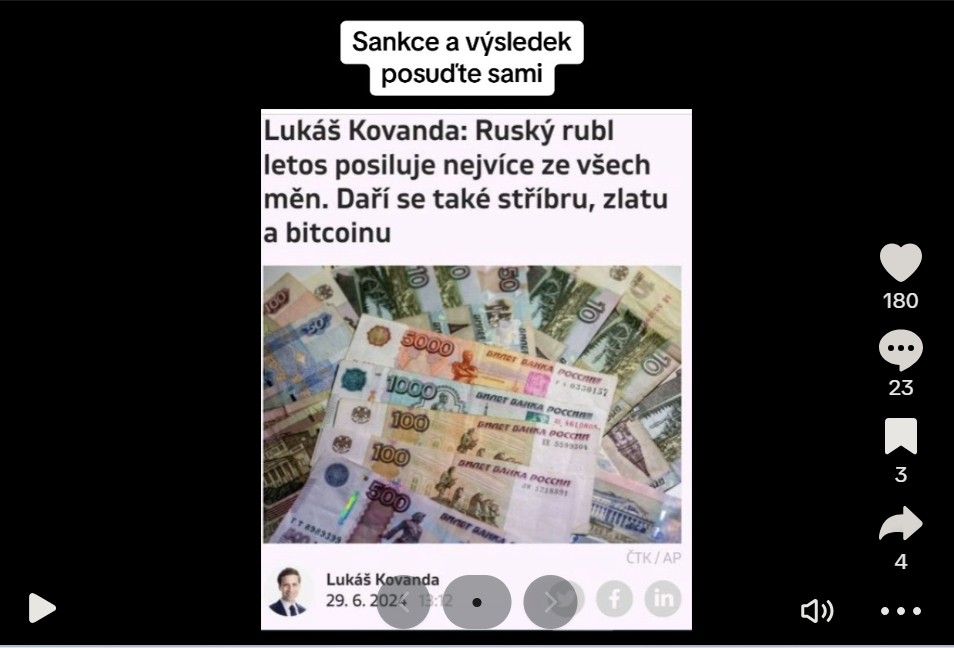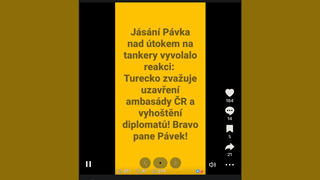
Does the appreciation of the Russian ruble against the U.S. dollar prove that Western sanctions against Russia are not working? No, it doesn't: Economists argue that the relationship between sanctions and exchange rate developments is not one-to-one and that the effectiveness of sanctions cannot be inferred from the exchange rate. In some cases, sanctions can paradoxically strengthen the sanctioned country's domestic currency, and thus using exchange rate developments as evidence of sanctions' impact can be contradictory or misleading. Also, the article used as evidence in a post circulating on social media does not link the ruble exchange rate to sanctions.
The claim appeared in a video (archived here) published on TikTok on July 2, 2024. It showed a screenshot of an article headline in Czech saying that the Russian ruble has strengthened against the U.S. dollar more than other currencies in the first six months of 2024. The text overlay on the video says in Czech, translated by Lead Stories staff as:
The sanctions and the result, judge for yourself.

(Source: TikTok screenshot taken on Fri Jul 5 07:05:55 2024 UTC)
The video above shows an article published on the Czech website Newstream.cz on June 29, 2024 (archived here). The commentary on currency and commodity markets' developments in the first half of 2024 is authored by a chief economist at Trinity Bank Lukas Kovanda (archived here), who also published it on LinkedIn (archived here). Kovanda says in the article that the Russian ruble has appreciated the most against the U.S. dollar of any major currency so far this year, gaining 4.3 percent in the first half of the year, while the vast majority of other currencies weakened against the dollar in the first six months of 2024. The euro lost nearly three percent, the Czech koruna 4.3 percent, and the Swiss franc as much as 6.4 percent. Kovanda uses data from Bloomberg, and the article includes a screenshot of Bloomberg data showing the ruble and other currencies appreciating or depreciating against the U.S. dollar.
In the article, Kovanda cites the Central Bank of Russia's tight monetary policy as the "key" reason for the ruble's appreciation in the first half of 2024. Kovanda also mentions that such tight financial conditions are limiting Russia's demand for imports, which is also contributing to the ruble's appreciation. The article, which also mentions the movements of other commodities such as gold, silver, or currencies such as the U.S. dollar or bitcoin, does not mention the Western sanctions against Russia and does not link their effectiveness to currency fluctuations at all. So, the commentary superimposed on the TikTok video in Czech, implying doubts about the impact of sanctions on Russia and considering the ruble rate as proof that they are not working, is not based on anything Kovanda says in the article, as falsely alluded to in the TikTok.
There have been attempts to link the ruble rate to the effectiveness of sanctions (archived here), but economists say the relationship is complex and, paradoxically, in some cases sanctions may even have helped boost the sanctioned country's domestic currency rate. The Center for Economic Policy Research published a column in July 2023, explaining the reasons for the ruble´s swings (archived here) since the invasion of Ukraine began. It says that the sanctions' effect on the exchange rate "depends on the balance of currency demand and supply," which can explain the developments in the ruble exchange rate since the Russian invasion of Ukraine began. The article also says that the impact on the exchange rate depends on the type of sanctions and that import restrictions are associated with the sanctioned country´s currency appreciation, which applies to the ruble as well.
In February 2022, the Russian ruble quickly lost almost half of its value. However, a few weeks later, the value of the ruble began to appreciate, and a few months later, it was higher than before the war. The U.S. dollar to the Russian ruble rate from September 2020 to July 2024 can be followed here (archived here).
Another column published on the Intereconomics think tank website in 2022, calls using the development of the ruble rate as proof that the sanctions are not working, or claiming that the Russian economy is resilient against them, "misleading and contradictory" (archived here).








